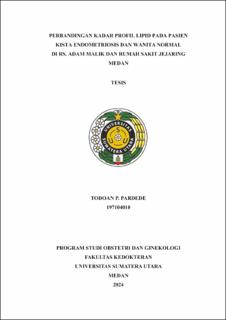| dc.description.abstract | Background. Endometriosis, affecting 10% of reproductive age women, is linked to pelvic pain, infertility, and reduced quality of life. Dyslipidemia is common in these patients, characterized by elevated triglycerides (TG) and LDL, and reduced HDL due to inflammation and oxidative stress. TG and LDL worsen inflammation, while HDL provides anti inflammatory protection. Lipid profile assessment may help manage endometriosis and control disease progression.
Methods. This case control study was conducted at three hospitals from February 2024 until the target sample size was reached. The case group included reproductive age women with endometriosis cysts, while the control group included healthy reproductive age women. Exclusion criteria were comorbidities (e.g., hypertension, diabetes, autoimmune diseases), use of certain medications, alcohol consumption, recent hormonal contraception, malnutrition, or smoking. Blood samples were collected for lipid profile analysis.
Results. Patients with endometriosis cysts were generally older than those in the control group (33.88 vs. 27.81 years) and were more likely to be married (75% vs. 25%). The average body mass index (BMI) was similar between the two groups (23.62 vs. 23.04 kg/m²), with most participants having a normal BMI. Significant differences were observed in HDL levels, which were lower in patients with endometriosis cysts (45.12 vs. 62.94 mg/dl, p=0.009), and LDL levels, which were higher (170.13 vs. 132.94 mg/dl, p=0.013). Although total cholesterol and triglyceride levels were higher in patients with endometriosis cysts, these differences were not statistically significant.
Conclusion. Patients with endometriosis cysts are older and more likely to be married than those without gynecological conditions. While BMI is similar between groups, they show lower HDL and higher LDL levels. Elevated total cholesterol and triglycerides were observed but not statistically significant. These findings highlight a potential link between endometriosis cysts and lipid abnormalities, particularly reduced HDL and increased LDL. | en_US |


